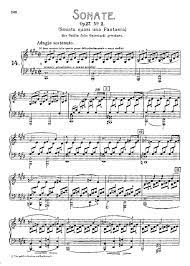Exploring Moonlight Sonata Sheet Music
The “Moonlight Sonata,” officially known as Piano Sonata No. 14 in C-sharp minor, Op. 27, No. 2, is one of Ludwig van Beethoven’s most iconic and beloved compositions. Written in 1801, this masterpiece has captivated audiences for centuries with its hauntingly beautiful melodies and emotional depth.
For musicians and music enthusiasts looking to delve into the intricacies of this timeless piece, having access to the Moonlight Sonata sheet music is essential. The sheet music provides a detailed musical score that allows performers to interpret and play the composition with precision and nuance.
Key Features of Moonlight Sonata Sheet Music
When exploring the Moonlight Sonata sheet music, one can expect to encounter several key features that contribute to the overall experience of playing this renowned piece:
- Detailed Notation: The sheet music includes precise notation of the musical elements such as notes, rhythms, dynamics, and articulations, providing a roadmap for performers to follow.
- Phrasing and Expression Marks: Phrasing and expression marks guide musicians on how to shape each phrase melodically and convey the intended emotions of the piece.
- Tempo Markings: Tempo markings indicate the speed at which the music should be played, helping performers maintain the appropriate pacing throughout the composition.
- Fingering Suggestions: Some editions of the sheet music may include fingering suggestions to assist pianists in navigating complex passages with ease.
Interpreting Moonlight Sonata
While reading from the Moonlight Sonata sheet music provides a foundation for playing the composition accurately, it is equally important for performers to infuse their interpretation with personal expression and artistry. Each musician brings a unique perspective to their performance, shaping the piece in a way that resonates with their individual style and emotions.
Whether you are a seasoned pianist or an aspiring musician eager to explore classical repertoire, delving into the Moonlight Sonata sheet music offers a rewarding musical journey filled with beauty, complexity, and profound emotion.
Mastering Moonlight Sonata: 5 Essential Tips for Interpreting Beethoven’s Classic Sheet Music
- Pay attention to the dynamics for a nuanced performance.
- Practice the arpeggios slowly to ensure accuracy and evenness.
- Focus on bringing out the melody while maintaining control in the accompaniment.
- Take note of any pedal markings for proper sustain and resonance.
- Study the phrasing and articulation to convey the expressive elements of the piece.
Pay attention to the dynamics for a nuanced performance.
To truly capture the essence of the “Moonlight Sonata” and deliver a compelling performance, it is crucial to pay close attention to the dynamics indicated in the sheet music. Dynamics play a vital role in shaping the emotional landscape of the piece, allowing for contrasts in volume, intensity, and expression. By carefully observing and interpreting the dynamic markings, musicians can infuse their rendition with depth, subtlety, and nuance, elevating the overall interpretation of this iconic composition to new heights.
Practice the arpeggios slowly to ensure accuracy and evenness.
When practicing the arpeggios in the Moonlight Sonata sheet music, it is crucial to approach them with patience and precision. By practicing these passages slowly and methodically, musicians can focus on achieving accuracy and evenness in their playing. This deliberate practice allows for a deeper understanding of the intricate patterns within the arpeggios, ultimately leading to a more polished and expressive performance of this iconic piece by Beethoven.
Focus on bringing out the melody while maintaining control in the accompaniment.
When interpreting the Moonlight Sonata sheet music, it is crucial to focus on bringing out the melody with clarity and expression, as it carries the emotional essence of the piece. Simultaneously, maintaining control in the accompaniment ensures a balanced and harmonious performance. By emphasizing the melody while skillfully managing the accompaniment, musicians can create a captivating rendition that captures the intricate beauty and depth of Beethoven’s iconic composition.
Take note of any pedal markings for proper sustain and resonance.
When delving into the intricacies of the Moonlight Sonata sheet music, it is crucial to take note of any pedal markings provided in the score. Pedal markings play a vital role in determining the proper sustain and resonance of the piano notes, adding depth and richness to the performance. By following these markings diligently, musicians can achieve the desired tonal effects and capture the ethereal quality that defines this iconic composition. Paying attention to pedal usage enhances the overall interpretation of the Moonlight Sonata, allowing performers to convey its emotional depth with clarity and authenticity.
Study the phrasing and articulation to convey the expressive elements of the piece.
To fully capture the emotional depth and beauty of the “Moonlight Sonata,” it is crucial to study the phrasing and articulation present in the sheet music. By paying close attention to these elements, musicians can convey the expressive nuances and subtleties that define this iconic composition. The phrasing guides the shaping of melodies, while articulation markings help in delivering the intended dynamics and accents, adding layers of emotion and depth to the performance. Mastering these aspects allows performers to communicate the profound sentiments embedded within the music, creating a truly captivating rendition of Beethoven’s masterpiece.

